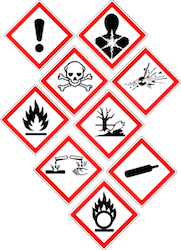Hazard communication, also known as HazCom, is a set of processes and procedures that employers and importers must implement in the workplace to effectively communicate hazards associated with chemicals during handling, shipping, and any form of exposure. Here’s what you need to know about hazard communication, including regulations, Safety Data Sheets (SDS), and label requirements.
When employees work with chemicals, they face a number of health hazards, including irritation, and physical hazards, such as flammability and corrosion. The United States Occupational Safety and Health Administration (OSHA) stipulates that chemical manufacturers and importers must evaluate the hazards of the chemicals with which they deal and pass along that information through labels and safety data sheets. Similarly, any employer with hazardous chemicals in the workplace must design and institute a written hazard communication program, which includes labeling all containers, giving all employees access to safety data sheets, and conducting a training program for all employees who could be exposed to the hazards. OSHA’s Hazard Communication Standard (HCS) specifies how to communicate information about the hazards and how to take protective measures.
The HCS ensures employees have the right to know the chemicals to which they are exposed in the workplace and their hazards. Employees not only must have access to the information, but they also must participate in employers’ training programs and know how to actively and effectively protect themselves. The Hazard Communication Standard also informs employers about designing and implementing these  effective protective programs for employees who could be exposed to hazardous chemicals. OSHA’s overall goal is to reduce the number of chemical source illnesses and injuries in workplaces across the nation.
effective protective programs for employees who could be exposed to hazardous chemicals. OSHA’s overall goal is to reduce the number of chemical source illnesses and injuries in workplaces across the nation.
In 2012, OSHA began aligning the HCS with the Globally Harmonized System of Classification and Labeling of Chemicals (GHS). The updated HCS ensures a consistent approach to classifying chemicals and communicating hazard information on labels and safety data sheets. As a result, American businesses more easily trade, handle, store, and use hazardous chemicals. They also realize cost savings because they no longer have to comply with numerous classification and labeling systems.
The updated HCS enables companies and organizations to streamline their safety data sheets and labels to comply with one system, the GHS. As of June 1, 2016, all companies must comply with the GHS.
Safety data sheets must provide comprehensive information about substances and mixtures used in workplaces. It’s worth noting that OSHA’s HazCom Standard refers to the GHS safety data sheets as material safety data sheets, or MSDS. They are an informational source about hazards and include safety precautions. They also assist employers in developing active programs for worker protection measures and training that are specific to the workplace and in considering the necessary measures for protecting the environment.
One of the major changes to the Hazard Communication Standard is the 16-section format of safety data sheets. The information in a safety data sheet must appear in this order:
The HCS requires chemical manufacturers, importers, and distributors to label each container of  hazardous chemicals leaving the workplace. These labels must include a product identifier, signal word, hazard statement(s), precautionary statement(s), and pictogram(s) in addition to the name, address, and telephone number of the chemical manufacturer, importer, or other responsible party.
hazardous chemicals leaving the workplace. These labels must include a product identifier, signal word, hazard statement(s), precautionary statement(s), and pictogram(s) in addition to the name, address, and telephone number of the chemical manufacturer, importer, or other responsible party.
One of the most significant changes to HazCom labels after alignment with the GHS is the pictograms OSHA adopted to improve worker safety and health. The pictograms themselves are graphic symbols that communicate specific information about chemical hazards. To be compliant, the pictogram must include a red square frame set at a point with a black hazard symbol on a white background that is wide enough to be clearly visible. Please note, square red frames set at a point must contain a hazard symbol to be permitted on the label; without the hazard symbol, the graphic cannot be considered a compliant pictogram.
The GHS includes a total of nine pictograms, but OSHA enforces only eight because they do not regulate the environmental impacts of chemicals. However, the environment pictogram may appear on a label as supplemental information. The eight pictograms OSHA does regulate include health hazard, flame, exclamation mark, gas cylinder, corrosion, exploding bomb, flame over circle, and skull and crossbones. The labels must be legible, printed in English, and prominently displayed. Furthermore, employers are responsible for maintaining labels on containers including tanks, totes, and drums.
Images via Pixabay by skeeze and Clker-Free-Vector-Images
Our sales engineers are experts in automatic asset tracking, tagging and identification,a nd can answer all your questions. Get in touch now.
Lets Talk ›